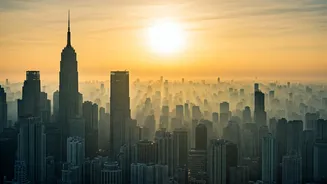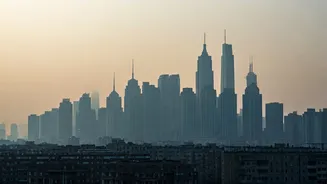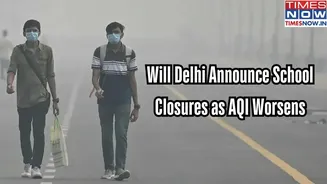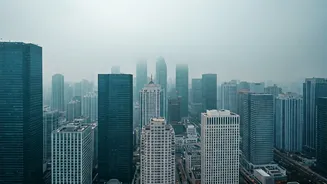AQI: A Dire Reality
The Delhi-NCR region is currently experiencing extremely poor air quality. The Air Quality Index (AQI) indicates a severely polluted environment, with
levels described as 'hazardous.' The data reveals that Delhi residents are, in effect, exposed to pollution comparable to smoking 15 cigarettes each day. This alarming comparison vividly illustrates the severity of the air pollution crisis. The implications of this are far-reaching, affecting both short-term and long-term health, prompting widespread concern among public health officials and the general population. The hazardous conditions are a major public health concern, calling for immediate action and mitigation strategies. This information emphasizes the urgent need for interventions to alleviate the problem and protect public health. The details further highlight the necessity for sustained environmental policies and enforcement to curb the sources of pollution, leading to improved air quality and a healthier environment.
Health Risks Amplified
Exposure to such elevated levels of air pollution presents serious risks to the population. The primary immediate impacts include respiratory problems and irritation to eyes and throat. The long-term effects could be more severe, contributing to chronic diseases and exacerbating existing health conditions, especially among vulnerable groups like children, the elderly, and individuals with pre-existing respiratory issues. The situation is further complicated by the potential for increased susceptibility to infections. The continuous exposure could lead to reduced overall well-being, diminishing the quality of life for the residents of Delhi-NCR. Such an unhealthy environment is a matter of serious concern. Healthcare professionals and researchers are deeply worried about the rise in respiratory and cardiac problems. They strongly advise preventive measures. These include wearing masks and avoiding strenuous outdoor activities to mitigate the health hazards. The data indicates that immediate and long-term consequences are likely, underscoring the urgency for intervention.
Government Response Needed
Addressing the crisis requires a multifaceted approach by the government and relevant stakeholders. Immediate actions could include implementing stricter measures to control pollution sources. These include industrial emissions, vehicular traffic, and construction activities. Long-term strategies necessitate a robust framework for clean air initiatives, promoting sustainable practices, and creating public awareness campaigns. A decisive governmental response could involve strengthening air quality monitoring systems to provide real-time information and facilitate effective interventions. Such interventions need to include the adoption of cleaner technologies, the promotion of public transportation, and investment in green infrastructure. Government action plays a crucial role in reducing harmful emissions and improving air quality for citizens. Furthermore, it should include public health advisories and support systems to assist vulnerable populations in coping with the hazardous air quality. The government’s role involves ensuring that the policies are effective and the implementation is consistent. This is essential for protecting the health of the population.














